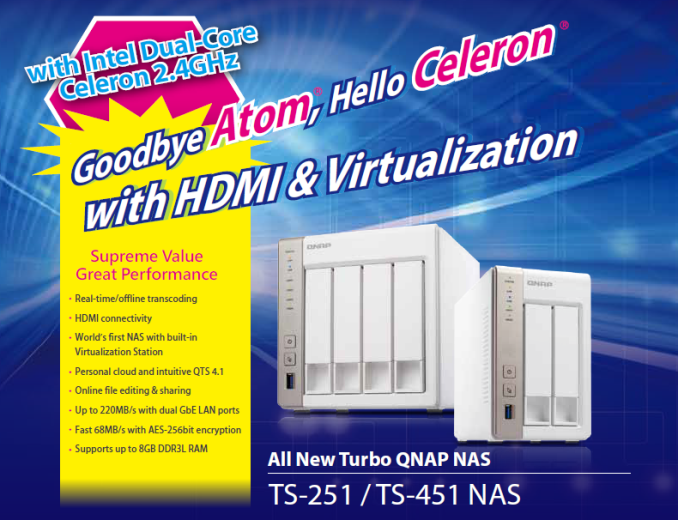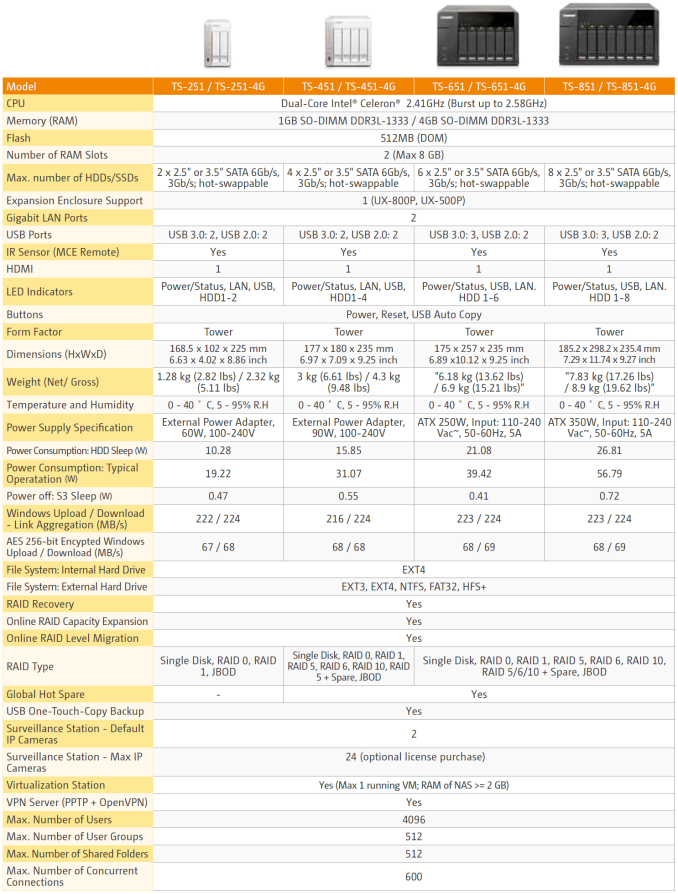QNAP TS-x51 NAS Series: Intel Quick Sync Gets its Killer App
by Ganesh T S on June 22, 2014 6:45 PM EST
Introduction
At Computex 2014, we visited QNAP and came away with a lot of information (some of which we had already seen at CES). After Computex, QNAP got in touch with me to better explain the various features of the newly introduced TS-x51 series (which was not at CES). And, boy, was I floored?! Usually, you don't see me getting very excited over product announcements. They usually get a small write-up with analysis in our pipeline section. However, I believe that QNAP's TS-x51 family has the capability to revolutionize the NAS market for home users and media enthusiasts, particularly in the way it utilizes Intel Quick Sync technology. It also gives us an opportunity to understand the state of the market and where it is headed.
The consumer / SOHO / SMB NAS market (which, in our definition, is comprised of units costing less than $5K) has two major platform vendors. In the cost-sensitive low power / performance segment, we have Marvell, with its ARM-based SoCs. Units requiring higher processing power (where cost is not a primary factor) have typically utilized Intel's x86 platforms. Over the last year or so, the delineation has been blurring quite a bit. Marvell's ARMADA 370 is no slouch when it comes to CPU performance, and it integrates a healthy number of PCIe and SATA lanes. On the other hand, Intel realized that its Bonnell-based D525 and D27xx-based solutions for the NAS market (which required an additional PCH) were not particularly power or cost efficient. While announcing its Silvermont architecture last year, Intel mentioned that the Bonnell follow-up would be part of multiple SoCs for microservers (Avoton) as well as other infrastructure equipment (Rangeley). It was widely expected that NAS vendors would move to Silvermont soon for their x86-based units. We were expecting some announcements at CES, but there was really nothing new.
QNAP's TS-x51 series has been introduced into the market just as it is on the verge of a major change. The details of the various members of the TS-x51 series are provided below. The Celeron CPU mentioned in the first row happens to be the J1800.
Before analyzing the product line and its features, let us take a short detour to understand Intel's play in this market.











49 Comments
View All Comments
rikm - Sunday, June 22, 2014 - link
the slide says "All new tubro" , kind of like turbo, but not quite that fast?wintermute000 - Sunday, June 22, 2014 - link
look forward to benches + real world transcoding testing.In particular want to see if everything is covered or there are any notable exceptions in terms of codec/container
SilthDraeth - Sunday, June 22, 2014 - link
Tubro, faster than snailro, just barely.ganeshts - Monday, June 23, 2014 - link
Didn't see that typo in their marketing brochure, to be honest :)Just spent some time fixing up the image at my end, so it should be OK now.
[-Stash-] - Monday, June 23, 2014 - link
Quick, hit the Turbo Button!steveoat - Sunday, June 22, 2014 - link
Looks interesting. What will be the costs of the 4 and 6 bay units?DanNeely - Sunday, June 22, 2014 - link
Probably similar to that of their current x69 series which are $540/712 for the bay and $782/925 for the 6 bay models on Amazon depending on if you go with the L or Pro models.Skarn - Sunday, June 22, 2014 - link
I'll be looking forward to seeing a full review of these units once samples become available. I'd especially like to know if the GPU driver baked in to drive the HDMI port fix the tearing problems I've seen on Sandy Bridge GPUs. While the feature set is sufficient that I'd be interested in these units despite this issue, I find tearing quite bothersome. I'd also be interested in seeing a full list of supported video codecs.ganeshts - Monday, June 23, 2014 - link
I wouldn't hold my hopes too high.. Intel GPUs' Linux drivers for video playback have historically been 'unreliable'. (That is why I wasn't too enthused about XBMC and HDMI output on the Evansport-based NAS units from Thecus and Asustor).That said, the list of supported codecs for transcoding input would definitely be something to evaluate and look into in greater details.
haardrr - Monday, June 23, 2014 - link
the latest intel drivers for linux 14.04 are amazing... (at least for the mythtv)...i know mythtv is NOT the same as a NAS box...
BUT, if the OS on this NAS is 14.04 (or similiar) you should not have any of the problems you have described.